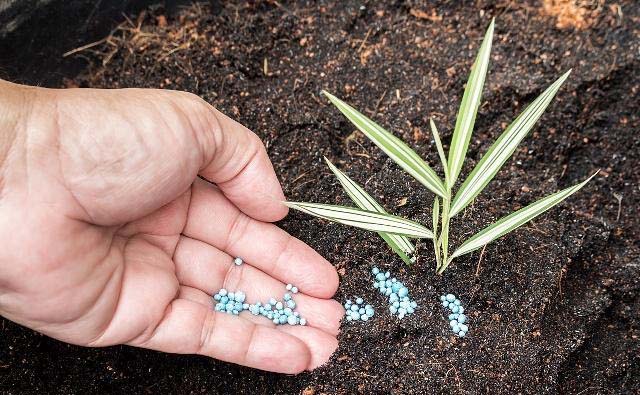What is the difference between controlled release fertilizer, slow release fertilizer and compound fertilizer
VIEWS: times Release Date:2020-06-29

1. Controlled release fertilizer:
By covering the nitrogen-phosphorus-potassium compound fertilizer or the nutrient fertilizer supplemented with trace elements with a layer of film and additives, the decomposition and release time of the fertilizer is prolonged, and the utilization of fertilizer nutrients is improved. Long-acting fertilizer.
Although they are both long-acting fertilizers like slow-release fertilizers, there are still essential differences in release methods and nutrition. The nutrients of controlled-release fertilizers are more comprehensive than slow-release fertilizers. They contain not only nitrogen, phosphorus, and potassium, but also some other trace elements (iron, zinc, and boron), which can meet all the growth needs of potted flowers in different growth periods. Common types include sulfur coating, resin coating, and urinary enzyme inhibitors.
In the release method, the nutrients of the water-soluble fertilizer wrapped in the film are slowly released by the outer coating. When the coated fertilizer particles contact the wet soil, the moisture in the soil penetrates into the fertilizer through the coating, thereby A part of the fertilizer is dissolved, this part of the water-soluble nutrients through the micropores in the film slowly and continuously spread out a release method. From the point of view of release method, it mainly depends on the thickness of the film and the level of soil temperature. That is, the thinner the outer membrane and the higher the soil temperature, the faster the release of nutrients.
2. Slow-release fertilizer:
Literally, it is a slow-release fertilizer, which is the opposite of a compound fertilizer, an instant fertilizer. It is mainly a single nitrogen fertilizer (a fertilizer with only nitrogen), which slowly releases the chemical element of nitrogen, and is an organic nitrogen compound that is decomposed under biological or chemical action, thereby transforming into a long-acting fertilizer for plants. From the point of view of nutrients, compared to controlled-release fertilizers, the ingredients are relatively simple and less water-soluble (in water or in contact with water does not accelerate the release of nutrients).
From the perspective of release method, it is mainly affected by chemical and biological activities. Generally affected by the following five external factors, soil pH value, microbial activity, soil moisture content, soil type and irrigation water volume, that is, these biological activities and soil quality, and the more and more frequent irrigation water, the faster the release rate . The main function is to supplement the nitrogen needed during plant growth. Common nitrogen slow-release fertilizers include: urea formaldehyde, oxalamide, isobutanediurea, and dicyandiamide, cyanide, and other inhibitors that slow down the release of nitrogen.
Broadly speaking, both controlled-release fertilizers and slow-release fertilizers are a type of compound fertilizer, and are three-element fertilizers of nitrogen, phosphorus and potassium. However, strictly speaking, the compound fertilizer that we commonly use for flower pot growing is a compound instant long-acting fertilizer containing two or three elements of nitrogen, phosphorus and potassium.
From the function point of view, it has the advantages of high nutrient content, few auxiliary components, and good physical properties. It not only improves the soil and activates beneficial microorganisms in the soil, but more importantly saves energy and reduces environmental pollution. For balanced fertilization, it improves fertilizer utilization. Rate, promoting the growth of potted flowers has a very important role. Compared with the other two fertilizers, the nutrient ratio is always fixed, and the types, quantities, and ratios of nutrients required by different soils and different crops are diverse.
Previous : The best way to use compound fertilizer
Next : Best NPK fertilizer for Ginseng fruit
Latest News
- The company overcame difficulties and won a "good start" in the first quarter ...2022-03-28
- Safe Production ...2022-03-28
- first-line collection ...2022-03-26
- Huaqiang News ...2022-03-26
- Huaqiang Chemical Strong Agriculture Project ...2022-03-25
- huaqiang news ...2022-03-24
- winning unit ...2022-03-22
- Huaqiang News ...2022-03-21
Related Information
- The best fertilizers for fruits and crops ...2020-05-26
- Huaqiang Chemical Group NPK fertilizer pdf ...2020-04-01
- Humic Acid Fertilizer ...2019-12-31
- Bulk Blending Fertilizer ...2019-12-27
- Water Soluble Fertilizer ...2019-12-08
- NPK Fertilizer ...2019-12-02
- Potassium Sulfate Fertilizer ...2019-11-30
- Urea Fertilizer ...2019-11-21
MESSAGE
Our sales staff will be the first time to get in touch with you,to provide you with the latest price.
-
Chemical Products
-
Compound fertilizer
-
Contact Us
Huaqiang Chemical Group Stock Co.,Ltd.
No.1 Jinping Avenue, Dangyang , Hubei , China
Http://www.hq-chemical.com
info@hq-chemical.com
Tel:+86 717 3431866
Mobile: +86 18627120543
© Copyright 2021 Huaqiang Chemical Group Stock Co.,Ltd. All Rights Reserved



